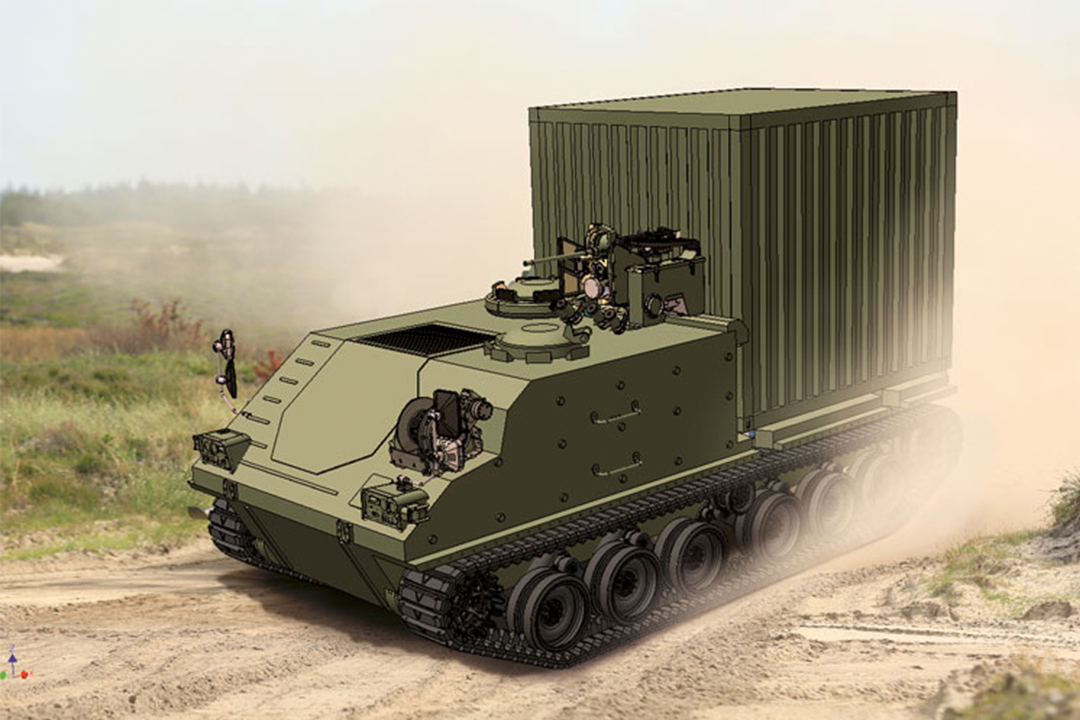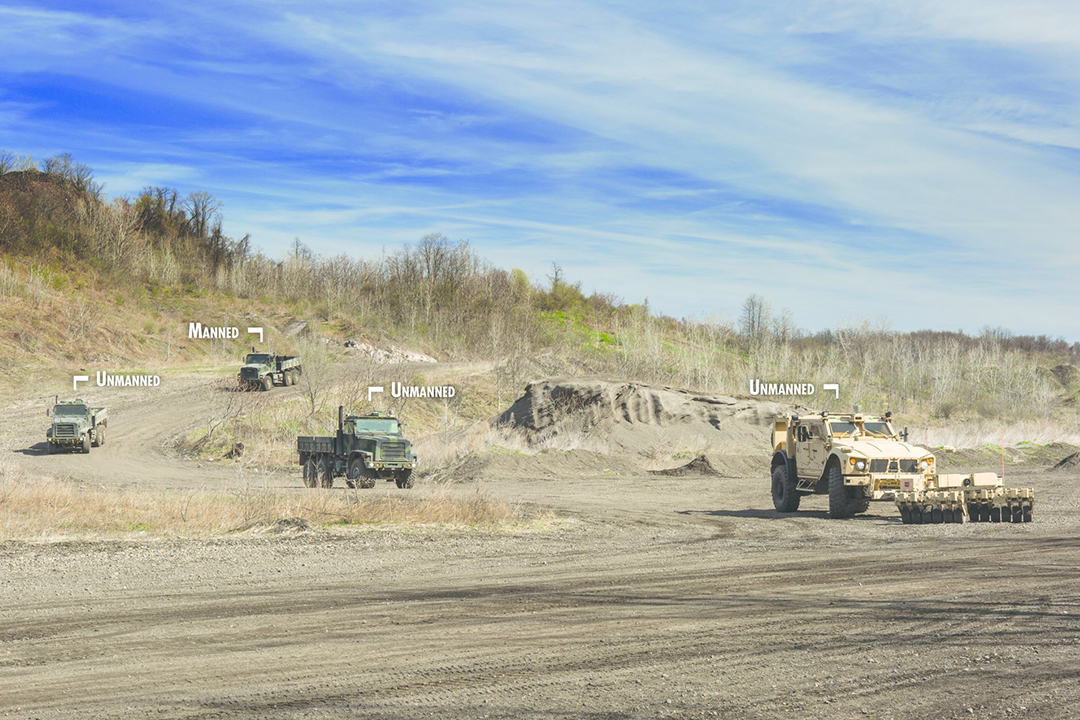
Published in the October/November 2020 issue – Logistical resupply may not seem glamorous but it is critical to success or failure in combat, particularly when forces are dispersed or in a peer-to-peer conflict.
Providing fighting arms with the essentials of ammunition, food, water, fuel, parts and the many other items is a constant challenge, with the supply of ammunition being one of the most crucial tasks among these. Moving, storing and delivering ordnance ranging from small arms bullets, to artillery shells, rockets, and guided missiles, also referred to as Class V, requires organisation, procedure and assets specific to that task. To accomplish this in a variety of terrain, weather, and tactical scenarios often requires specifically designed equipment and systems.
Artillery Ammunition
Moving and delivering artillery and larger mortar rounds from storage magazines to forward combat users confronts major and unique difficulties. These items are heavy, difficult to handle and often utilise special packing for safe storage and transport. They also can also be consumed in large quantities quickly when active combat occurs requiring moving large amounts of munitions in short order. These factors combine to make it preferable that ammunition be moved with as little handling as possible. Ideally it should be delivered directly to the final user in the combat zone who may well be in contact with the enemy.
Reliably providing ammunition to artillery is especially critical yet with each projectile in the 155mm calibre around 40-50kg (88-110lbs) alone, plus its charges, it is not a simple task. In addition, in response to increasingly effective counter-battery capabilities artillery must be more mobile changing its location after fire missions which can preclude the stockpiling of ammunition at gun positions. The movement of artillery stocks forward was simplified by the adaption of a commercial technique combining the use of ‘flat racks’, essentially flat metal pallets with an assembly on one end which hooks into a lifting device on a specially equipped truck.
As Mike Ivy, senior vice president International Programs at Oshkosh Defence, a principle supplier of the US Army Palletised Load System (PLS) explained, “It is a simple yet extremely efficient system. The PLS configured truck backs up to the rack, the driver deploys the hook attaching to the assembly on the flatrack and then lifts it onto the rear chassis. The entire process takes under a minute. Upon reaching the delivery point he reverses the process lowering the flatrack to the ground. The hook automatically disengages and the driver is able to depart never leaving the cab.”
The PLS and United Kingdom DROPS (dismountable rack offload and pickup system) as well as compatible similar French, German and other NATO systems use a standardised rack with a 15 metric ton (16.5 short ton) capacity. Further developments have provided a flatrack compatible trailer, a container handling unit that can carry 20ft ISOs with need for a flat rack and the CROPS (containerised roll-in/roll-out platform) where the rack fits inside the ISO. An Enhanced PLS includes the Movement Tracking System (MTS) that monitors the location and displays the load using a Global Positioning System (GPS). It also provides two-way digital messaging to both track logistics assets and redirect them to a new delivery site as necessary. Given the increasingly fluid nature of the forward battle space, the targeting of artillery and its associated resupply elements, and the push for forward resupply the armouring of the PLS and other logistics vehicles undertaken in response to insurgent attacks has taken on a new importance. By providing previously lacking protection to drivers it enhances their ability to perform closer to the enemy less threatened by indirect fire shrapnel.
Readily supplying artillery does not end with the dropping of the flatrack. It must then be transferred to the guns themselves. This remains a key problem for towed guns, however, it is being addressed in a number of self-propelled artillery through AARVs (Armoured Ammunition Resupply Vehicles). The Republic of Korea’s Hanwha K10 is noteworthy it its approach to addressing this task. ShinYoung Park Manager Overseas Business Team at Hanwha Land Systems explained ” K10 is teamed with Hanwha’s K9 Thunder self-propelled 155mm howitzer. It is a fully-automated ammunition carrier and reloading system. Its task is to replenish the K9 using its 104 projectiles and 504 propellant charges. It collects these from resupply trucks or forward stocks and moves them directly to the Thunder. Crewmen of neither vehicle are exposed in the transfer process which can move 10 rounds per minute over its electrically driven telescoping arm meaning it can completely rearm a K9 in five minutes. The K10 provides for the secure availability of ammunition for the guns without taking them off-line and loosing their firepower at a critical moment.”

Combat Replenishment
Mechanised combat units have the benefit of a vehicle which can carry additional supplies of ammunition for both its weapons and those of embarked infantry. As a result they have greater combat endurance and can engage in fire fights with less concern of running low on ammunition. Onboard ammunition stocks increase the ability for mechanised and motorised forces to conduct extended independent combat action.
Reducing the demand to replenish Class V also permits focus on other demands such as Class III – fuel. Still the intensity of combat can see high ammunition expenditures. Anticipating this a several armies have introduced armoured logistics and support vehicles, usually variants of an already widely fielded combat vehicle but configured with a large rear compartment specifically to accommodate loads. The US Marine Corps included a LAV- logistics variant in its fleet and currently the Canadian Forces are fielding their wheeled LAVIII Armoured Combat Support Vehicle (ACSV) with a cargo role. Norway has selected a tracked ASCV from FFG, plus the ARTEC Boxer family includes a cargo logistic module that can accept two standard one tonne pallets for the Dutch Army. The US Army’s Armoured Multi-Purpose Vehicle description suggests it also has a resupply capacity although it is not reflected as a specific mission.


For light infantry having adequate ammunition and other essential goods this is a continuous and serious concern. The dismounted soldier is limited to the ammunition that he is able to carry for a rifleman which may be around 80 rounds, for the machine gun team possibly 600 rounds, and for a light mortar crew maybe 20. This basic load can be quickly exhausted in an engagement when they need to be resupplied. The problem for these light units is their very limited capability for carrying additional ammunition close at hand and the difficulties in providing responsive resupply. This is particularly an issue for heavier ordnance like portable anti-tank guided missiles – a Javelin is 15.9kg (35lbs) – and mortar rounds This is further complicated by the need for a solution that can travel where the unit goes and should not take soldiers away from combat duties.
The development and use of autonomous ground vehicles is beginning to show as an alternative to this task. Systems like the Rheinmetall Defence Mission Master provide a small all-terrain capable cargo carrier that will carry 600kg (1320lbs) of ammunition and other supplies. Retired General Alain Tremblay, a vice president at the company shared that “a driving factor for Unmanned Ground Vehicles (UGVs) like Mission Master is the need to provide the essential capability without the need to dedicate soldiers to the task.” The US Army in July 2020 awarded a contact to General Dynamics Ordnance and Tactical Systems for a similar capability. Their multi-wheeled MUTT is to be fielded to units like the 82nd Airborne and 10th Mountain Divisions. Both had previous used light all-terrain vehicles like the Polaris MRZR but these require a soldier to drive. Polaris proposed an ‘optionally-manned’ version of its MRZR that program manager Patrick Zech said “allowed for both traditional driving even at high speeds and autonomous operation when preferred.” The MUTT and Mission Master can travel without soldier control either autonomously or automatically by following a soldier (referred to as ‘leader-follower’). With these robotic cargo carriers a rifle company could be accompanied by a resupply of readily available ammunition (33 cans of 5.56mm could be loaded on one MUTT). In addition, given advances in autonomous point-to-point navigation it may be also possible for these UGVs to be programmed to transport ammunition and other supplies from the rear to forward units.

Autonomous Convoys
Capitalising on the possibilities that robotics may offer, the concept of using current technologies to provide self-driving truck convoys is viewed as a way to more efficiently move supplies from depots with fewer soldiers. The idea is actually building off commercial demonstrations conducted as early as 2015 by Daimler Trucks with its Highway Pilot system. The US Army’s Expedient Leader-Follower envisions nine unmanned trucks with a soldier driving the lead. However, Oshkosh Defence and Robotic Research has suggested a completely autonomous convoy is within reach. Oshkosh’s program manager for Autonomous Vehicles, Chuck Bunton stated: “The technology does exist, but we are not there yet with acceptance”. Still the Army has proposed an Automated Ground Resupply Program for as early as 2022. The use of automated resupply offers definite benefits on well established and secure routes. How far the self navigating approach can currently be applied remains to be seen, particularly across unfamiliar terrain.

New Challenges for Combat Logistics
Resupplying in counter-insurgency presented extended communication routes that could be vulnerable to attack and disruption as well as the need to resupply remote outposts. Yet, future battlefields may be even more challenging. The presence of unmanned aerial systems over both forward and rear areas will make discrete movement and distribution of ammunition and fuel appreciably more difficult. This is coupled with the demonstrated capability for these detections to be quickly engaged by massive firepower. In addition, the anticipated increased dispersal and displacement of combat units will likely require logistics efforts to operate independently and able to take combat action to pursue their resupply missions. The enhanced difficulties in executing uninterrupted replenishment and increased need for these to be more rapidly accomplished is complicated by greater ammunition expenditures anticipated on the peer-on-peer battlefield. Past combat logistics processes and procedures now need extensive re-evaluation for conflict now and in the future.













